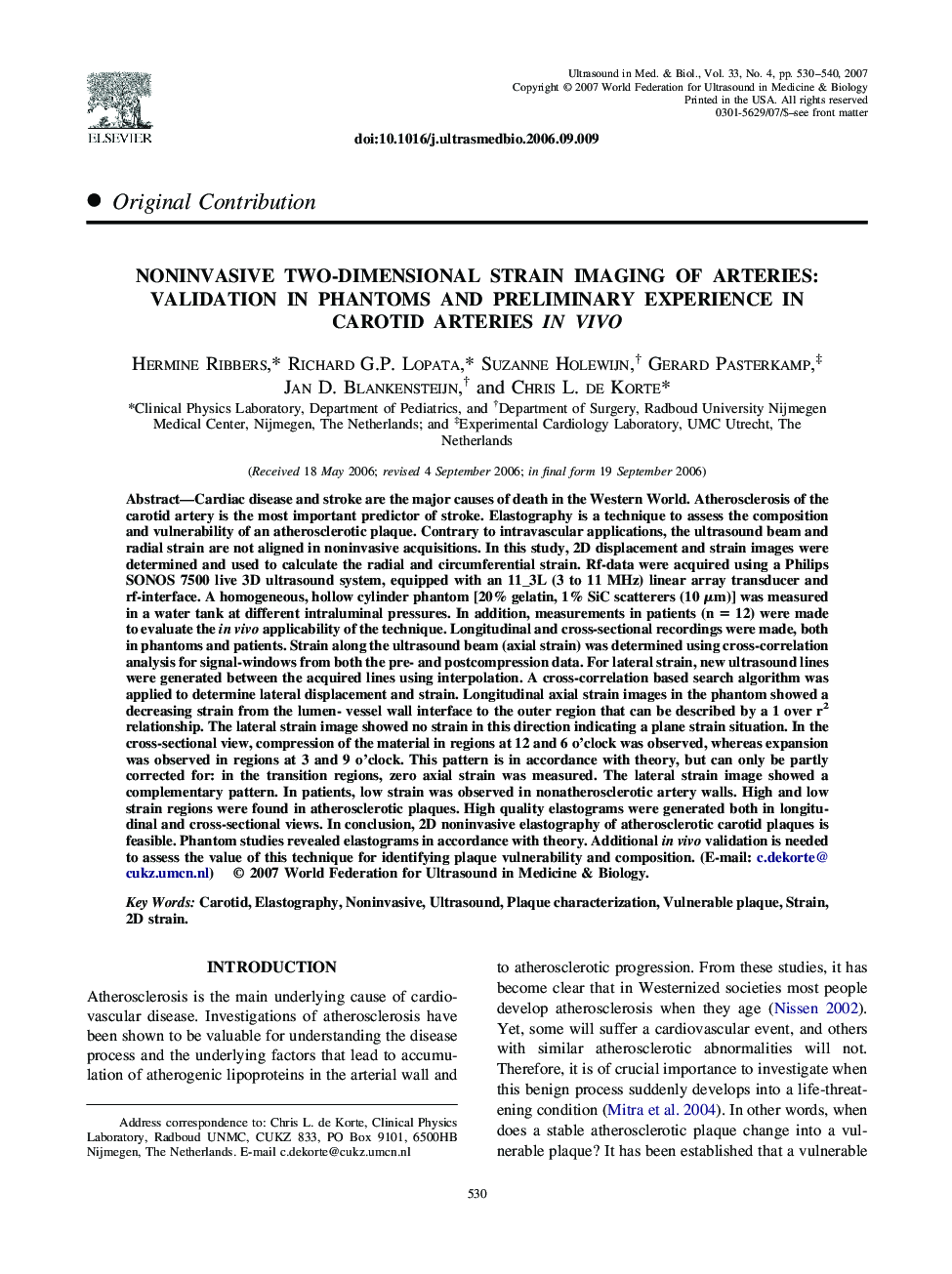| کد مقاله | کد نشریه | سال انتشار | مقاله انگلیسی | نسخه تمام متن |
|---|---|---|---|---|
| 1762555 | 1019700 | 2007 | 11 صفحه PDF | دانلود رایگان |
عنوان انگلیسی مقاله ISI
Noninvasive Two-Dimensional Strain Imaging of Arteries: Validation in Phantoms and Preliminary Experience in Carotid Arteries In Vivo
دانلود مقاله + سفارش ترجمه
دانلود مقاله ISI انگلیسی
رایگان برای ایرانیان
کلمات کلیدی
موضوعات مرتبط
مهندسی و علوم پایه
فیزیک و نجوم
آکوستیک و فرا صوت
پیش نمایش صفحه اول مقاله

چکیده انگلیسی
Cardiac disease and stroke are the major causes of death in the Western World. Atherosclerosis of the carotid artery is the most important predictor of stroke. Elastography is a technique to assess the composition and vulnerability of an atherosclerotic plaque. Contrary to intravascular applications, the ultrasound beam and radial strain are not aligned in noninvasive acquisitions. In this study, 2D displacement and strain images were determined and used to calculate the radial and circumferential strain. Rf-data were acquired using a Philips SONOS 7500 live 3D ultrasound system, equipped with an 11_3L (3 to 11 MHz) linear array transducer and rf-interface. A homogeneous, hollow cylinder phantom [20% gelatin, 1% SiC scatterers (10 μm)] was measured in a water tank at different intraluminal pressures. In addition, measurements in patients (n = 12) were made to evaluate the in vivo applicability of the technique. Longitudinal and cross-sectional recordings were made, both in phantoms and patients. Strain along the ultrasound beam (axial strain) was determined using cross-correlation analysis for signal-windows from both the pre- and postcompression data. For lateral strain, new ultrasound lines were generated between the acquired lines using interpolation. A cross-correlation based search algorithm was applied to determine lateral displacement and strain. Longitudinal axial strain images in the phantom showed a decreasing strain from the lumen- vessel wall interface to the outer region that can be described by a 1 over r2 relationship. The lateral strain image showed no strain in this direction indicating a plane strain situation. In the cross-sectional view, compression of the material in regions at 12 and 6 o'clock was observed, whereas expansion was observed in regions at 3 and 9 o'clock. This pattern is in accordance with theory, but can only be partly corrected for: in the transition regions, zero axial strain was measured. The lateral strain image showed a complementary pattern. In patients, low strain was observed in nonatherosclerotic artery walls. High and low strain regions were found in atherosclerotic plaques. High quality elastograms were generated both in longitudinal and cross-sectional views. In conclusion, 2D noninvasive elastography of atherosclerotic carotid plaques is feasible. Phantom studies revealed elastograms in accordance with theory. Additional in vivo validation is needed to assess the value of this technique for identifying plaque vulnerability and composition. (E-mail: c.dekorte@cukz.umcn.nl)
ناشر
Database: Elsevier - ScienceDirect (ساینس دایرکت)
Journal: Ultrasound in Medicine & Biology - Volume 33, Issue 4, April 2007, Pages 530-540
Journal: Ultrasound in Medicine & Biology - Volume 33, Issue 4, April 2007, Pages 530-540
نویسندگان
Hermine Ribbers, Richard G.P. Lopata, Suzanne Holewijn, Gerard Pasterkamp, Jan D. Blankensteijn, Chris L. de Korte,